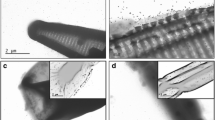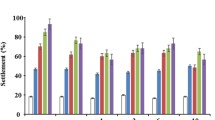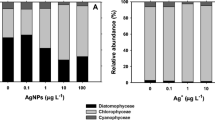Abstract
Bacterial biofilms are most likely confronted with silver nanoparticles (Ag NPs) as a pollutant stressor in aquatic systems. In this study, biofilms of Aquabacterium citratiphilum were exposed for 20 h to 30 and 70 nm citrate stabilized Ag NPs in low-dose concentrations ranging from 600 to 2400 μg l−1, and the Ag NP-mediated effects on descriptive, structural, and functional biofilm characteristics, including viability, protein content, architecture, and mechanical stability, were investigated. Viability, based on the bacterial cell membrane integrity of A. citratiphilum, as determined by epifluorescence microscopy, remained unaffected after Ag NP exposure. Moreover, in contrast to information in the current literature, protein contents of cells and extracellular polymeric substances (EPS) and biofilm architecture, including dry mass, thickness, and density, were not significantly impacted by exposure to Ag NPs. However, the biofilms themselves served as effective sinks for Ag NPs, exhibiting enrichment factors from 5 to 8. Biofilms showed a greater capacity to accumulate 30 nm sized Ag NPs than 70 nm Ag NPs. Furthermore, Ag NPs significantly threatened the mechanical stability of biofilms, as determined by a newly developed assay. For 30 nm Ag NPs, the mechanical stability of biofilms decreased as the Ag NP concentrations applied to them increased. In contrast, 70 nm Ag NPs produced a similar decrease in mechanical stability for each applied concentration. Overall, this finding demonstrates that exposure to Ag NPs triggers remarkable changes in biofilm adhesion and/or cohesiveness. Because of biofilm-mediated ecological services, this response raises environmental concerns regarding Ag NP release into freshwater systems, even in sublethal concentrations.





Similar content being viewed by others
References
Arvin E (1991) Biodegradation kinetics of chlorinated aliphatic hydrocarbons with methane oxidizing bacteria in an aerobic fixed biofilm reactor. Water Res 25:873–881
Baek YW, An YJ (2011) Microbial toxicity of metal oxide nanoparticles (CuO, NiO, ZnO, and Sb2O3) to Escherichia coli, Bacillus subtilis, and Streptococcus aureus. Sci Total Environ 409:1603–1608
Blaser SA, Scheringer M, MacLeod M, Hungerbühler K (2008) Estimation of cumulative aquatic exposure and risk due to silver: contribution of nano-functionalized plastics and textiles. Sci Total Environ 390:396–409
Boenigk J, Beisser D, Zimmermann S, Bock C, Jakobi J, Grabner D et al (2014) Effects of silver nitrate and silver nanoparticles on a planktonic community: general trends after short-term exposure. PLoS One 9(4)
Chaw KC, Manimaran M, Tay FE (2005) Role of silver ions in destabilization of intermolecular adhesion forces measured by atomic force microscopy in Staphylococcus epidermidis biofilms. Antimicrob Agents Chemother 49:4853–4859
Chen X, Stewart PS (2002) Role of electrostatic interactions in cohesion of bacterial biofilms. Appl Microbiol Biotechnol 59:718–720
Chen R, Choudhary P, Schurr RN, Bhattacharya P, Brown JM, Ke PC (2012) Interaction of lipid vesicle with silver nanoparticle-serum albumin protein corona. Appl Phys Lett 100:013703
Choi O, Hu Z (2008) Size dependent and reactive oxygen species related nanosilver toxicity to nitrifying bacteria. Environ Sci Technol 42:4583–4588
Choi O, Deng KK, Kim NJ, Ross L, Surampalli RY, Hu Z (2008) The inhibitory effects of silver nanoparticles, silver ions, and silver chloride colloids on microbial growth. Water Res 42:3066–3074
Choi O, CP Y, Fernández GE, Hu Z (2010) Interactions of nanosilver with Escherichia coli cells in planktonic and biofilm cultures. Water Res 44:6095–6103
Christensen BE, Characklis WG (1990) Physical and chemical properties of biofilms. Methods Enzymol 93
Dror-Ehre A, Mamane H, Belenkova T, Markovich G, Adin A (2009) Silver nanoparticle–E. coli colloidal interaction in water and effect on E. coli survival. J Colloid Interface Sci 339:521–526
Dror-Ehre A, Adin A, Markovich G, Mamane H (2010) Control of biofilm formation in water using molecularly capped silver nanoparticles. Water Res 44:2601–2609
Duran N, Silveira CP, Duran M, Martinez DST (2015) Silver nanoparticle protein corona and toxicity: a mini-review. J Nanobiotechnol 13
Fabrega J, Fawcett SR, Renshaw JC, Lead JR (2009a) Silver nanoparticle impact on bacterial growth: effect of pH, concentration, and organic matter. Environ Sci Technol 43:7285–7290
Fabrega J, Renshaw JC, Lead JR (2009b) Interactions of silver nanoparticles with Pseudomonas putida biofilms. Environ Sci Technol 43:9004–9009
Fabrega J, Zhang R, Renshaw JC, Liu WT, Lead JR (2011) Impact of silver nanoparticles on natural marine biofilm bacteria. Chemosphere 85:961–966
Finsy R (1994) Particle sizing by quasi-elastic light scattering. Adv Colloid Interf 52:79–143
Flemming HC, Wingender J (2010) The biofilm matrix. Nat Rev Microbiol 8:623–633
Gardener M (2012) Exploring data – looking at numbers. In: statistics for ecologists using R and excel. Pelagic Publishing, Exeter, p. 76
Gerbersdorf SU, Wieprecht S (2015) Biostabilization of cohesive sediments: revisiting the role of abiotic conditions, physiology and diversity of microbes, polymeric secretion, and biofilm architecture. Geobiology 13:68–97
Gil-Allué C, Schirmer K, Tlili A, Gessner MO, Behra R (2015) Silver nanoparticle effects on stream periphyton during short-term exposures. Environ Sci Technol 49:1165–1172
González AG, Mombo S, Leflaive J, Lamy A, Pokrovsky OS, Rols JL (2015) Silver nanoparticles impact phototrophic biofilm communities to a considerably higher degree than ionic silver. Environ Sci Pollut Ress 22:8412–8424
Gottschalk F, Sun T, Nowack B (2013) Environmental concentrations of engineered nanomaterials: review of modeling and analytical studies. Environ Pollut 181:287–300
Harrison JJ, Ceri H, Turner RJ (2007) Multimetal resistance and tolerance in microbial biofilms. Nat Rev Microbiol 5:928–938
Hwang ET, Lee JH, Chae YJ, Kim YS, Kim BC, Sang BI, MB G (2008) Analysis of the toxic mode of action of silver nanoparticles using stress-specific bioluminescent bacteria. Small 4:746–750
Ikuma K, Decho AW, Lau BL (2015) When nanoparticles meet biofilms—interactions guiding the environmental fate and accumulation of nanoparticles. Front Microbiol 6:591
Kaegi R, Voegelin A, Ort C, Sinnet B, Thalmann B, Krismer J et al (2013) Fate and transformation of silver nanoparticles in urban wastewater systems. Water Res 47:3866–3877
Kakinen A, Ding F, Chen PY, Mortimer M, Kahru A, Ke PC (2013) Interaction of firefly luciferase and silver nanoparticles and its impact on enzyme activity. Nanotechnology 24:345101
Kalmbach S, Manz W, Szewzyk U (1997) Isolation of new bacterial species from drinking water biofilms and proof of their in situ dominance with highly specific 16S rRNA probes. Appl Environ Microbiol 63:4164–4170
Kang F, Alvarez PJ, Zhu D (2014) Microbial extracellular polymeric substances reduce Ag+ to silver nanoparticles and antagonize bactericidal activity. Environ Sci Technol 48:316–322
Klitzke S, Metreveli G, Peters A, Schaumann GE, Lang F (2015) The fate of silver nanoparticles in soil solution – sorption of solutes and aggregation. Sci Total Environ 535:54–60 Special Issue: Engineered nanoparticles in soils and waters
Kroll A, Behra R, Kaegi R, Sigg L (2014) Extracellular polymeric substances (EPS) of freshwater biofilms stabilize and modify CeO2 and Ag nanoparticles. PLoS One 9(10)
Kroll A, Matzke M, Rybicki M, Obert-Rauser P, Burkart C, Jurkschat K et al (2015) Mixed messages from benthic microbial communities exposed to nanoparticulate and ionic silver: 3D structure picks up nano-specific effects, while EPS and traditional endpoints indicate a concentration-dependent impact of silver ions. Environ Sci Pollut R 1–17
Larson F, Lubarsky H, Gerbersdorf SU, Paterson DM (2009) Surface adhesion measurements in aquatic biofilms using magnetic particle induction: MagPI. Limnol Oceanogr Methods 7:490–497
Lemire JA, Harrison JJ, Turner RJ (2013) Antimicrobial activity of metals: mechanisms, molecular targets and applications. Nat Rev Microbiol 11:371–384
Li X, Lenhart JJ (2012) Aggregation and dissolution of silver nanoparticles in natural surface water. Environ Sci Technol 46:5378–5386
Lok CN, Ho CM, Chen R, He QY, WY Y, Sun H et al (2006) Proteomic analysis of the mode of antibacterial action of silver nanoparticles. J Proteome Res 5:916–924
Mah TFC, O’Toole GA (2001) Mechanisms of biofilm resistance to antimicrobial agents. Trends Microbiol 9:34–39
Mayer C, Moritz R, Kirschner C, Borchard W, Maibaum R, Wingender J, Flemming HC (1999) The role of intermolecular interactions: studies on model systems for bacterial biofilms. Int J Biol Macromol 26:3–16
Metreveli G, Philippe A, Schaumann GE (2015) Disaggregation of silver nanoparticle homoaggregates in a river water matrix. Sci Total Environ 535:35–44
Metreveli G, Frombold B, Seitz F, Grün A, Philippe A, Rosenfeldt RR et al (2016) Impact of chemical composition of ecotoxicological test media on the stability and aggregation status of silver nanoparticles. Environ Sci. Nano 3:418–433
Moreno-Garrido I, Pérez S, Blasco J (2015) Toxicity of silver and gold nanoparticles on marine microalgae. Mar Environ Res 111:60–73
Morones JR, Elechiguerra JL, Camacho A, Holt K, Kouri JB, Ramírez JT, Yacaman MJ (2005) The bactericidal effect of silver nanoparticles. Nanotechnology 16:2346
Navarro E, Piccapietra F, Wagner B, Marconi F, Kaegi R, Odzak N et al (2008) Toxicity of silver nanoparticles to Chlamydomonas reinhardtii. Environ Sci Technol 42:8959–8964
Newton RJ, Jones SE, Eiler A, McMahon KD, Bertilsson S (2011) A guide to the natural history of freshwater lake bacteria. Microbiol Mol Biol Rev 75(1):14–49
Ostermeyer AK, Mumuper CK, Semprini L, Radniecki T (2013) Influence of bovine serum albumin and alginate on silver nanoparticle dissolution and toxicity to Nitrosomonas europaea. Environ Sci Technol 47:14403–14410
Pal S, Tak YK, Song JM (2007) Does the antibacterial activity of silver nanoparticles depend on the shape of the nanoparticle? A study of the gram-negative bacterium Escherichia coli. Appl Environ Microbiol 73:1712–1720
Pan X, Liu J, Zhang D, Chen X, Li L, Song W, Yang J (2010) A comparison of five extraction methods for extracellular polymeric substances (EPS) from biofilm by using three-dimensional excitation-emission matrix (3DEEM) fluorescence spectroscopy. Water SA 36:111–116
Pillai ZS, Kamat PV (2004) What factors control the size and shape of silver nanoparticles in the citrate ion reduction method? J Phys Chem B 108:945–951
Pillai S, Behra R, Nestler H, Suter MJF, Sigg L, Schirmer K (2014) Linking toxicity and adaptive responses across the transcriptome, proteome, and phenotype of Chlamydomonas reinhardtii exposed to silver. Proc Natl Acad Sci 111:3490–3495
R Core Team (2013) R: A language and environment for statistical computing. Version 3.0.1. R Foundation for Statistical Computing, Vienna, Austria [Online] http://www.R-project.org. Accessed Aug 08, 2013
Radniecki TS, Stankus DP, Neigh A, Nason JA, Semprini L (2011) Influence of liberated silver from silver nanoparticles on nitrification inhibition of Nitrosomonas europaea. Chemosphere 85:43–49
Reidy B, Haase A, Luch A, Dawson KA, Lynch I (2013) Mechanisms of silver nanoparticle release, transformation and toxicity: a critical review of current knowledge and recommendations for future studies and applications. Materials 6:2295–2350
Reinsch BC, Levard C, Li Z, Ma R, Wise A, Gregory KB et al (2012) Sulfidation of silver nanoparticles decreases Escherichia coli growth inhibition. Environ Sci Technol 46:6992–7000
Sadeghi B, Garmaroudi FS, Hashemi M, Nezhad HR, Nasrollahi A, Ardalan S, Ardalan S (2012) Comparison of the anti-bacterial activity on the nanosilver shapes: nanoparticles, nanorods and nanoplates. Adv Powder Technol 23:22–26
Schaumann GE, Philippe A, Bundschuh M, Metreveli G, Klitzke S, Rakcheev D et al (2015) Understanding the fate and biological effects of Ag-and TiO 2-nanoparticles in the environment: the quest for advanced analytics and interdisciplinary concepts. Sci Total Environ 535:3–19
Sheng Z, Liu Y (2011) Effects of silver nanoparticles on wastewater biofilms. Water Res 45(18):6039–6050
Silver S, Phung LT, Silver G (2006) Silver as biocides in burn and wound dressings and bacterial resistance to silver compounds. J Ind Microbiol Biot 33:627–634
Sondi I, Salopek-Sondi B (2004) Silver nanoparticles as antimicrobial agent: a case study on E. coli as a model for gram-negative bacteria. J Colloid Interface Sci 275:177–182
Sotiriou GA, Pratsinis SE (2010) Antibacterial activity of nanosilver ions and particles. Environ Sci Technol 44:5649–5654
Staudt C, Horn H, Hempel DC, Neu TR (2004) Volumetric measurements of bacterial cells and extracellular polymeric substance glycoconjugates in biofilms. Biotechnol Bioeng 88:585–592
Teitzel GM, Parsek MR (2003) Heavy metal resistance of biofilm and planktonic Pseudomonas aeruginosa. Appl Environ Microbiol 69:2313–2320
Tejamaya M, Römer I, Merrifield RC, Lead JR (2012) Stability of citrate, PVP, and PEG coated silver nanoparticles in ecotoxicology media. Environ Sci Technol 46:7011–7017
Tolaymat TM, El Badawy AM, Genaidy A, Scheckel KG, Luxton TP, Suidan M (2010) An evidence-based environmental perspective of manufactured silver nanoparticle in syntheses and applications: a systematic review and critical appraisal of peer-reviewed scientific papers. Sci Total Environ 408:999–1006
Wang W, Wang YJ, Wang DQ (2008) Dual effects of tween 80 on protein stability. Int J Pharm 347:31–38
Wirth SM, Lowry GV, Tilton RD (2012) Natural organic matter alters biofilm tolerance to silver nanoparticles and dissolved silver. Environ Sci Technol 46:12687–12696
Wölz J, Cofalla C, Hudjetz S, Roger S, Brinkmann M, Schmidt B et al (2009) In search for the ecological and toxicological relevance of sediment re-mobilisation and transport during flood events. J Soils Sediments 9:1–5
Zhang W, Yao Y, Li KG, Huang Y, Chen YS (2011) Influence of dissolved oxygen on aggregation kinetics of citrate-coated silver nanoparticles. Environ Pollut 159:3757–3762
Acknowledgments
This study was supported by the German Research Foundation (DFG; Research unit INTERNANO: FOR 1536, subprojects BIOFILM MA3273/3-1 and MASK SCHA849/16). We thank U. Bange for the AAS measurements and K. Hoffmann, J. Tepper, C. Sodemann, and B. Schmidt for technical assistance. We are also grateful to Dr. W. Fey for the ICP-OES measurements.
Author information
Authors and Affiliations
Corresponding author
Ethics declarations
Notes
The authors declare no competing financial interest.
Additional information
Responsible editor: Thomas D. Bucheli
Electronic supplementary material
ESM 1
(DOC 738 kb)
Rights and permissions
About this article
Cite this article
Grün, A.Y., Meier, J., Metreveli, G. et al. Sublethal concentrations of silver nanoparticles affect the mechanical stability of biofilms. Environ Sci Pollut Res 23, 24277–24288 (2016). https://doi.org/10.1007/s11356-016-7691-0
Received:
Accepted:
Published:
Issue Date:
DOI: https://doi.org/10.1007/s11356-016-7691-0




